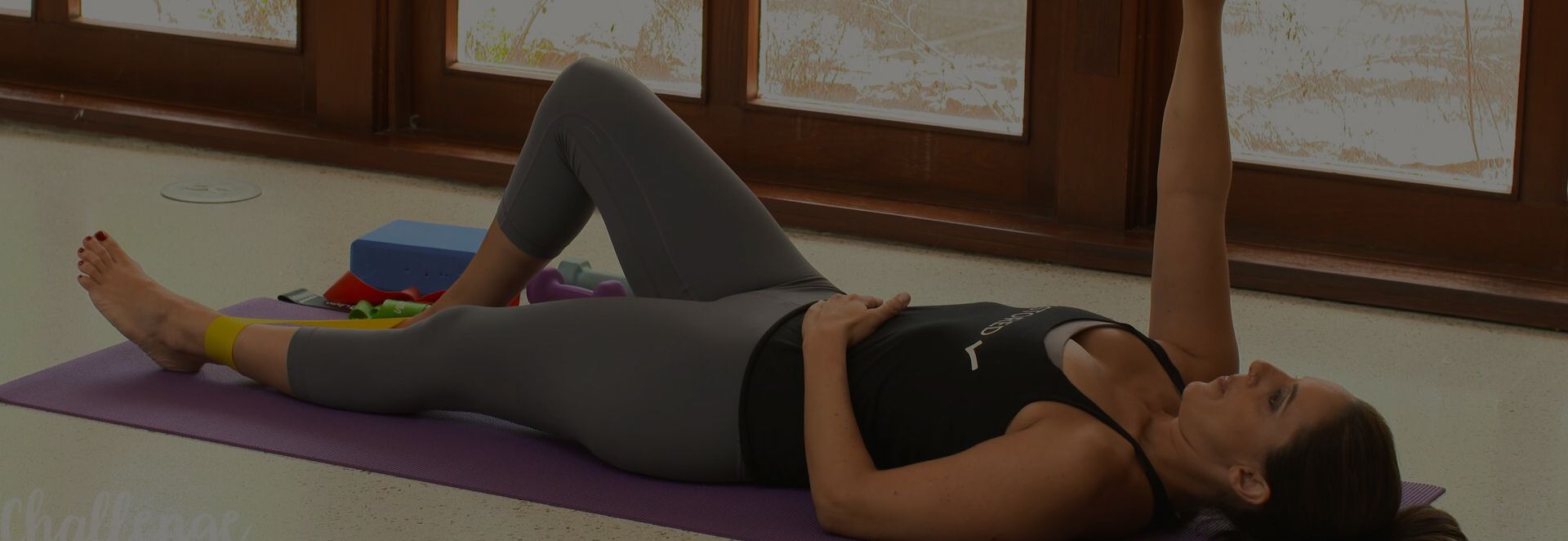Resources
Overcoming Breathing Problems After Hysterectomy: Tips and Techniques
By Lauren Ohayon 03/22/2024
4 Min Read
If you’re working with a client who has recently undergone a hysterectomy, they may come to you with complaints about breathing difficulties. This article will help you guide your clients experiencing breathing problems after a hysterectomy with techniques and exercises to aid in recovery and improve respiratory health. Because the risk for post-surgical respiratory problems is well-documented, always make sure your client has seen their doctor about breathing issues first.
Table of Contents
Common Respiratory Issues Post-Hysterectomy
As with other major surgeries, many respiratory issues that arise post-hysterectomy are related to the body undergoing anesthesia–approximately 12% of patients who have hysterectomies will have some sort of breathing problem after surgery. The risk increases with age, low body weight, and a higher use of opioids during surgery.
Longer-term, the mechanics of respiration require the core and pelvic floor to function synergistically, a task that may need to be relearned post-hysterectomy. Many people are given breathing exercises to do while recovering from their hysterectomies. Still, you may find that you need to work with a client on longer-term recovery from surgery-related breathing problems.

Immediate Post-Surgery Breathing Challenges
I want to give you a little context for what your client may have experienced. Immediately following surgery, most people are monitored in the hospital for proper respiration. While under anesthesia, the breathing rate slows down, and mucus can collect in the lungs. Mucus left to linger in the lungs too long can cause several other complications, such as infection and collapsed lobes in the lung.
In order to help the lungs stay clear post-surgery, patients are usually given an incentive spirometer–a device that measures the breath–to practice taking long, deep inhales. Patients are generally instructed to take 10-15 breaths with the incentive spirometer every couple of hours. They can hold a pillow over their abdomen if this deep breathing causes discomfort or pain; people whose hysterectomies were performed vaginally can use gentle pressure to hold a hand over the pad they’ll be wearing.
Coughing to clear mucus from the lungs is another technique that people may be encouraged to engage in immediately after hysterectomy. Again, using a pillow or hand over the surgical site to brace against can help alleviate the discomfort they might be feeling.
If you’re able to help your client prepare for surgery ahead of time, you might offer them this breathing and coughing combination to practice during their first few days of recovery:
-
- Inhale slowly, allowing your ribcage to expand fully
- Hold your breath for several seconds
- Exhale slowly
- After five breaths, brace your incision with your hand or a small pillow and attempt to cough
- Repeat several times per day until breathing and coughing are easier
Long-Term Breathing Complications
As a movement pro, you may work with your clients on improving their breathing patterns as they recover from longer-term complications like lung infections. People who experience conditions like pneumonia or atelectasis (partial collapse of a lung) should be working with a pulmonary specialist to manage their condition. However, as a core and pelvic floor expert, you can help facilitate that work by encouraging a three-dimensional breathing pattern and working to undo any compensation patterns that may arise as a result of the surgery.
Left unresolved, shortness of breath after hysterectomy can affect how active your clients are. If moving leaves them feeling out of breath, they may need extra encouragement to keep going. Helping them develop effective breathing patterns will help make the recovery process easier.
Breathing Exercises After Hysterectomy:
The following exercises may help your clients recover from shortness of breath after hysterectomy. Practicing these exercises yourself will assist you in generating your own prompts and cues to share with your clients.
Three-Dimensional Diaphragmatic Breathing:
- Sit or stand comfortably with good posture
- Place your hands on your ribcage, with thumbs toward the back of your body
- Inhale through your nose, allowing your rib cage to expand outward
- Exhale slowly and completely through your mouth or nose
- Feel your ribcage contract as you exhale
- Repeat this breathing pattern for several breaths, focusing on expanding and contracting your ribcage with each breath
- Follow up with a few relaxed breaths and notice whether your ribcage moves more easily with your breath
Pursed-Lip Breathing:
- Sit or lie down in a comfortable position
- Inhale slowly through your nose for about two seconds
- Pucker or purse your lips as if you’re about to blow out a candle
- Exhale slowly and gently through pursed lips for about four seconds
- Repeat this breathing pattern several times
Coordinated Breathing:
- Sit or lie down comfortably
- Place one hand on your belly and the other hand on your chest
- Inhale deeply through your nose
- Try to allow your rib cage to expand first, followed by a little bit of belly movement
- Exhale through pursed lips, allowing your belly hand to draw in first, then your chest hand
- Repeat this coordinated breathing pattern for several minutes, aiming for relaxation and stress relief
Progressive Relaxation Technique:
- Find a quiet and comfortable space to sit or lie down
- Start by tensing a specific muscle group in your body, such as your fists or shoulders, for about 5-10 seconds
- Release the tension suddenly and completely, allowing the muscles to relax fully
- Take a few deep breaths, focusing on the sensation of relaxation in the previously tensed muscles
- Move on to the next muscle group, such as your thighs or neck, and repeat the process of tensing and relaxing
- Continue this progression throughout your body, working from head to toe or vice versa
- Take your time with each muscle group, allowing yourself to fully relax before moving on to the next
- Finish by taking a few deep breaths and enjoying the overall feeling of relaxation in your body
- This exercise helps to reduce muscle tension and promote overall relaxation and well-being.
Incorporating Breathing Exercises into Daily Life
You will want to encourage your client to include these kinds of exercises in their daily life–particularly early on in their recovery, they may need things to do while their body heals, and breathing exercises are a great way to slowly begin introducing routines after hysterectomy. Later on, they can redirect their focus on breathing towards core rehabilitation. Once your client is at home and no longer under the care of nursing staff, they will need to continue to practice breathing exercises. You can suggest some simple ways to integrate their exercises, such as:
- Set an alarm
- Do one exercise every time they get up to use the bathroom
- Plan to do exercises before breakfast, lunch, dinner, and bedtime

A few final reminders about trouble breathing after hysterectomy
The number one tip is for your client to seek immediate medical attention if they experience breathing problems after discharge from the hospital–a lung infection, collapsed lung, or blood clot are all reasons your client may develop shortness of breath after hysterectomy surgery. Specific symptoms to watch out for:
- Shortness of breath
- Blue skin or lips
- Rapid heart or breathing rate
- Coughing or coughing up blood
- Chest pain
Once major medical issues have been ruled out, remind your clients that performing breathing exercises will help facilitate a quicker and more effective recovery and reduce the risk of developing complications. Moving around and getting up will also aid in their recovery. And doing both will help them get back to their normal routines. Healing after major surgery like a hysterectomy can be difficult; patience and consistent practice make it much better.
FAQ
1. Can breathing exercises prevent long-term respiratory issues post-hysterectomy?
Breathing exercises have been shown to reduce the likelihood of long-term respiratory issues after major surgery, including hysterectomy. Abdominal surgeries, in general, tend to increase the chance of breathing problems, so planning to perform breathing exercises during the immediate recovery period can help.
2. How often should I perform these breathing exercises?
Once every hour or two during the first week after surgery. You can reduce how much time you spend on them once you’re up and about more regularly, especially once your sutures have healed enough to cough and breathe normally.
3. Can breathing problems after hysterectomy indicate other health issues?
Yes, breathing problems after a hysterectomy can sometimes indicate other health issues. Post-operative complications such as pneumonia or blood clots can affect breathing. The risk of respiratory complications after hysterectomy increases with age, low body weight, and higher use of opioids during surgery.
4. Are these breathing exercises beneficial for all types of hysterectomy?
Since all types of hysterectomy involve a general anesthetic, yes, these exercises are good for all types of hysterectomy.
5. Should I consult a doctor before starting these exercises?
Yes. The information provided on this website is for educational and informational purposes only and is not intended as medical advice. It is not a substitute for professional medical advice, diagnosis, or treatment. Always seek the advice of your physician or other qualified health provider with any questions you may have regarding a medical condition.



